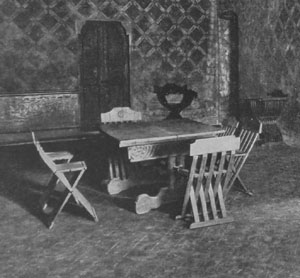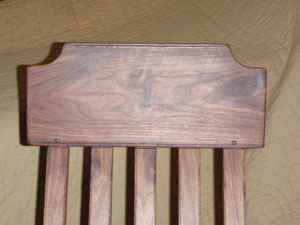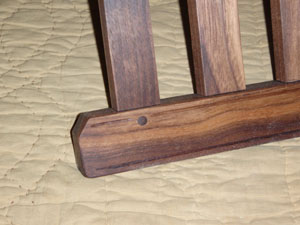Furniture
History & Design
The photo at left is a detail of a photo in Frida Schottmuller's 1921 book Furniture and Interior Decoration of the Italian Renaissance reproduced here without permission (is 90 years enough to put this in public domain?). I obtained the proportions for this chair by carefully scaling from this photo to standard modern seat height.
While it is not the most common type there are a good many surviving folding chairs of this style. They appear to have been popular in 16th century Italy and Germany. Although I've not seen this style attributed to craftsmen outside this area or earlier than the 16th century, my research has not been exhaustive.
As it happens, there are a number of details that make this style of chair tricky to work out.
- The back is at an angle to the staves. This is helps to keep you from leaning back beyond the rear foot and overbalancing.
- The seat is angled very slightly back. This helps keep your butt from sliding forward.
- The positions of the pivots are extremely critical. As little as 1/32nd inch difference in the position of the center seat slat pivot makes the difference between folding flat and not.
Materials
The chair is made from American black walnut. By the 16th century European walnut was a very popular furniture wood (outside of England). American black walnut is similar in appearance and physical properties. Its strength and light weight make it ideal for a chair that you might end up carrying around a bit. White oak would also be quite functional, though probably somewhat less 'period' for this peice. The finish is two coats of boiled linseed oil.
Cost
This chair is my prototype. Between fiddling around to get proportions right and doing almost all of the joinery by hand at Lilies war, I have something like 25-30 hours in it. Needless to say this would make the price prohibitive. I will be working on jigs and batch production to try and get the price down to a reasonable level. Interested parties contacting me regarding this would certainly 'up' the priority of my getting this done. nudge, nudge, wink, wink..
| |
|
©2009, 2010, 2011, & 2012 Gene Eisele
Privacy Policy
Contact Me
|










